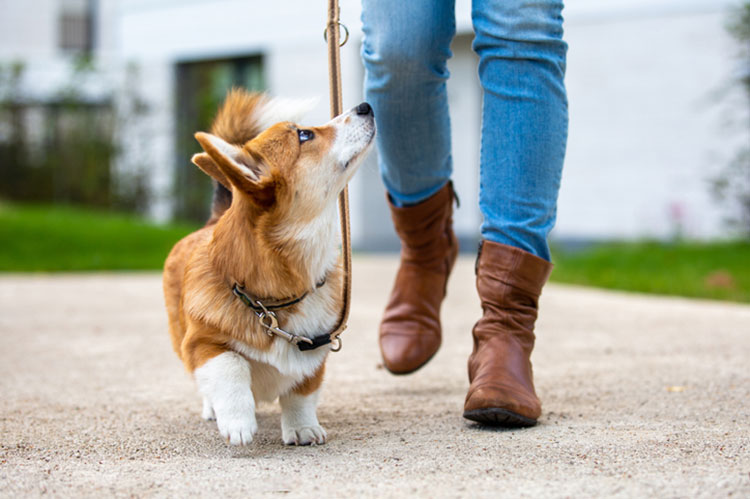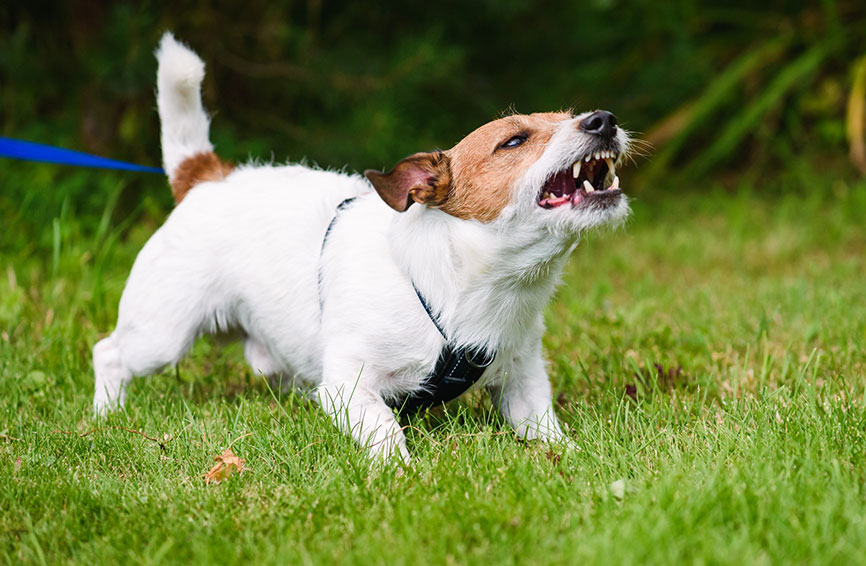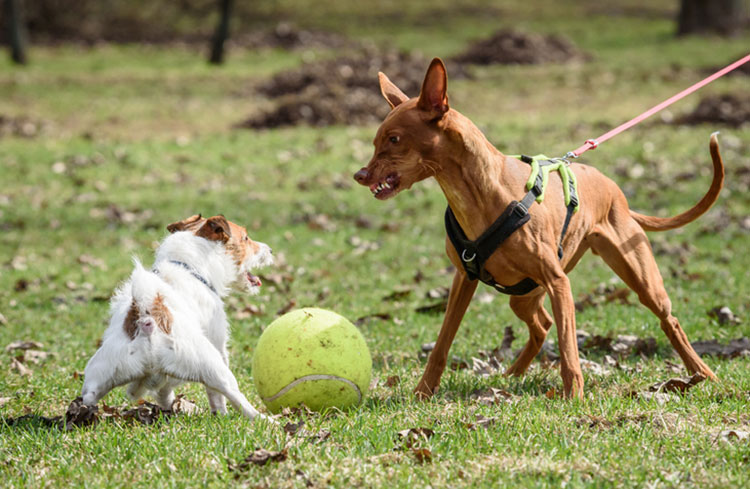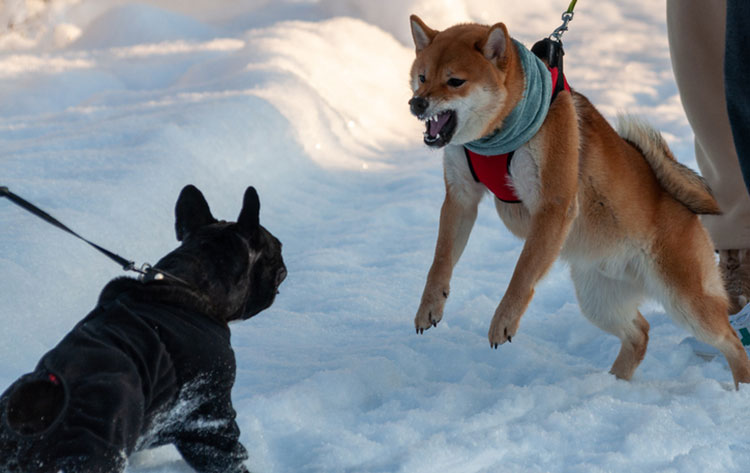Key Takeaways
- Dogs who lunge while on leash at other dogs are leash-reactive, making walks unpleasant or embarrassing for the pet parent.
- Dogs who are leash-reactive are usually responding out of fear.
- Pet parents can help their leash-reactive dogs by avoiding situations that scare them, or by slowly introducing them to calm, confident dog friends.
Table of Contents
Dogs who lunge and bark during on-leash walks are referred to as “leash reactive,” as opposed to a reactive dog who becomes overly aroused by everyday situations. Dogs lunge for different reasons, because they are excited and want to play with the other dog, or more commonly, due to fear. The fear reaction can look scary because of its intensity.
Why do some dogs only lunge on leash?
When on a leash, dogs can’t choose to flee, which can be stressful and overwhelming. Also, on a leash, the dogs are forced to approach head-on and are often unable to turn their bodies. Their forced body language can put dogs in a mindset that they have no option but to fight. Most dogs don’t want to fight, so they display several behaviors designed to prevent it. These include barking, lunging, or growling — anything to make the threat go away. This is their natural response but can be difficult for whoever is walking them and can cause the approaching dog to increase their reaction.
Why some dogs are reactive

For some extra sensitive dogs, they may not have even been attacked but may have witnessed another dog being attacked, and this experience alone was enough to cause them to feel afraid and insecure with other dogs.
No matter the dog’s experience of being attacked, just be aware their fear-reaction is coming from a very real place. Some dogs can feel comfortable around other dogs within a few months, while others may be afraid of all dogs, or those of a certain breed, size, sex, or color for the rest of their life.
These dogs are often unfairly labeled “aggressive.” These sensitive souls are judged for their natural, fearful reaction, which so often leads to them being abandoned, returned to a rescue organization, or euthanized. They were traumatized and are now exhibiting fear, the only way they can express their emotions.
A dog’s ability to recover from the trauma and change their reaction depends on their personality, history, and how they deal with stress. Obviously, the approach taken to address their behavior has a huge impact on how they heal from the trauma.
How to help your dog feel comfortable

Many dogs can learn, over time, to trust you enough to help them when they feel afraid. In these cases, avoiding other dogs, or giving space at first, is still the best tactic. This is easy to do if you take them on walks in places that allow you to easily get off the trail, with plenty of space to allow for a wide buffer as other dogs pass.
Practice giving them space on walks
Stand in between your dog and the other dog passing to show your dog you are protecting them. Get your pup’s attention and ask them to “Wait” as the dog passes, giving them a high-value treat and praise.
Practice walking off the path and asking your dog to “wait” when no one is approaching. This practice will make it easier for your dog to remember what to do when they are feeling anxious. You want to be able to get your dog’s attention regardless of what’s going on around you. The key is showing your dog that you are making the decisions on the walk, you are leading them and keeping them safe.
Yawning for comfort
You can yawn too, which will help your dog feel more relaxed. Yawning is a signal that everything is OK. It’s vital to keep your energy confident, grounded and calm, no matter how your dog is reacting, or you will inadvertently contribute towards their fearful reaction. If your dog feels any stress or anxiety from you, even if it’s due to their reaction, they will automatically assume that you are afraid of the dog too.
Creating positive experiences
To help change your dog’s reaction to dogs out on a walk, it’s important that they have lots of great interactions with other dogs in a controlled environment. Introduce them to one dog at a time, so that they aren’t overwhelmed, and you can closely observe their reactions. Slowly introduce them to other calm dogs to help them feel safe.
If your dog learns to enjoy another dog’s company and has comfortable experiences with several dogs, it’s a great start to changing their mind about other dogs. This is how to safely change their reaction to dogs on a walk but remember it will take a lot of time and patience, and this outcome may not be possible for some dogs.
Using the ‘Leave It’ command to stop lunging

Once your dog has learned to feel comfortable with some dogs and their stress level has decreased, you can start working with them on ‘Leave It‘ training. You can apply ‘Leave it’ if your dog is lunging because they want to play with another dog.
Ask someone who has a dog to help you. Start by taking your dog on a walk just outside your home, and don’t walk more than one house away on either side. Ask your friend to walk their dog on the other side of the street and slowly walk in the direction facing you as you walk your dog.
As you walk along the street, randomly change direction as you walk your dog, walk in a circle, stop, and ask them to ‘Wait’. This will help them focus on you, and it will make it easier for them to pay attention to you when they see another dog.
If your dog starts barking, lunging, or even staring at the other dog across the street, calmly ask them to ‘Leave It’ and say their name. If they don’t look at you and continue lunging, barking, or staring, take them straight inside your home and put them in a “time-out.”
As you escort them, don’t look at or talk to them and try to keep your energy calm and assertive. The best time-out space is usually the bathroom or a laundry room, a small room that separates your dog from the rest of the family. Once they are in the time-out room, remove the leash, turn on the light and leave them alone in the room for three minutes.
After three minutes, walk into the time-out room, don’t acknowledge them for a few minutes, and wait until they have stopped trying to get your attention. Then call them to you, put the leash on and take them back outside.
As you walk them outside, make sure they aren’t leading you. If they walk ahead of you, turn around and walk a few steps in the opposite direction, wait for 10 seconds, then start walking again. Ensuring that you are leading them and walking beside you will help them realize that they need to pay attention to you and that you are their leader outside of the house.
If your dog responds to ‘Leave It’ and stops barking, lunging, or staring, or looks at you for even a moment, say ‘Good Leave It’ and their name and give them a high-value treat.
Work on this for only 10 minutes at a time in the beginning, and slowly increase the time when your dog’s reaction lessons, and they can ‘Leave It’ more quickly. This training takes time and a lot of patience.
Also, remember that the more intense the other dog’s behavior, the harder it will be for your dog to react calmly and respond quickly to you. The key is to teach your dog self-control and focus on you if they feel nervous because you are their leader and protector.
Consider quality of life for highly sensitive and fearful dogs
Approach sensitive, traumatized dogs with patience, compassion, and the understanding that they are reacting to intense panic and fear of injury and possible death. It’s not realistic to expect a dog who is terrified of being killed to react in a calm way when they see a potential attacker. We need to listen to what dogs are telling us and respect how they feel, rather than punish them for being afraid.
A dog may be so reactive to other dogs that even going on a walk in the neighborhood can feel overwhelming and terrifying. In this case, it’s better to play fetch with them in your yard, or even take them for a walk in your yard if you have room.
You could also take them out to a less populated area, where you are a lot less likely to see another dog. Avoidance is key for some dogs who are highly sensitive and have a fear of other dogs. Why trigger their anxiety when you don’t need to? If they don’t enjoy leaving the house and walking in your neighborhood, then don’t make that your goal.
Every dog is unique
As every dog is unique, there is no cookie-cutter answer. There are many possible outcomes, and it’s important not to put any pressure on your dog to change but to take baby steps towards helping them. Focus on learning what their best life looks like, rather than being disappointed because they can’t live up to your expectations.
If you have a newly rescued dog, it’s vital to give your dog time to decompress, as it’s stressful and unsettling going from home to home. They will need time to adjust to their new family, expectations, and environment. Give them time and help them learn to feel safe and trust you before you begin to work on the most challenging fear-based behaviors.
What not to do when dealing with a leash-reactive dog
Some dog parents resort to shock collars, prong collars, or choke chains in the hopes of controlling their dog’s behavior when on walks. See my recent post about why these punitive measures are counterproductive.
Imagine you felt afraid when away from home because you saw someone who reminded you of being attacked and mugged in the past. To make the situation even more traumatic, while you felt afraid, a family member either sent an electric shock down your body or grabbed you by the neck and chocked you.
This sounds like abuse, doesn’t it? Yet, some dogs are treated this way when they feel afraid.
Many people say that their dog’s reaction intensified when they tried this controlling approach. If the dog did lessen their outward reaction, it wasn’t because they felt any differently, but that they were more afraid of the ‘attack’, so instead of reacting, held in their physical, natural response.
The problem with this is that when a dog suppresses their anxiety, fear, and panic, it doesn’t go away, it’s simply re-directed. Someone may notice that their dog is unable to settle when at home, they may bark more intensely when they see dogs passing by their home or yard, they may have increased separation anxiety, or just seem to be overall anxious. While other dogs may cower in a corner or start to shake when you get out the leash and corrective collar.
Our dogs are innocent beings, who trust us to take care of them, give them guidance and help them feel safe. They have emotions, just like people do, and we cannot suppress their emotions by using control, but we can learn to honor how they feel and how to help them trust us to keep them out of harm’s way.
Sarah-Anne Reed is a holistic dog trainer and owner of Pack Dynamics®. Her practice focuses on understanding and respecting dogs as a different species and honoring them as individual beings.
This article is copyrighted by Sarah-Anne Reed and Pack Dynamics®, and no reproduction of this article without the express permission of Sarah-Anne Reed is permitted.
25% discount for online dog training
Pack Dynamics® offers a unique online training program, ‘Fluent In Canine®‘. Learn how to understand your dog’s behavior and address typical behavioral issues, like separation anxiety, pulling on the leash, puppy issues, recall, and much more, as you create a deeper bond with your dog. Visit the Fluent In Canine® page and enter this code at checkout to receive 25% off: HPPI2022











